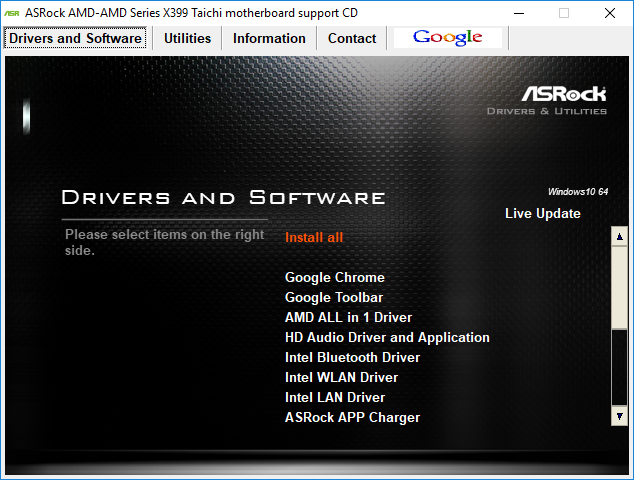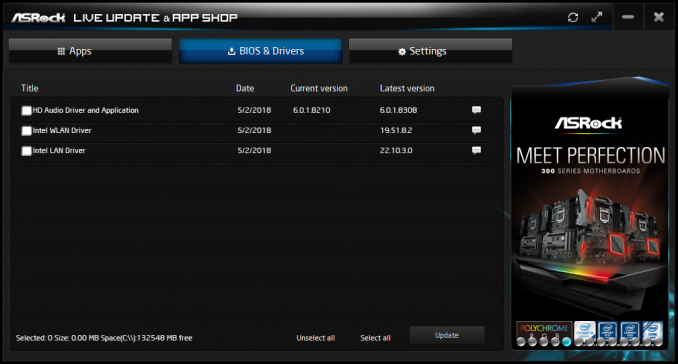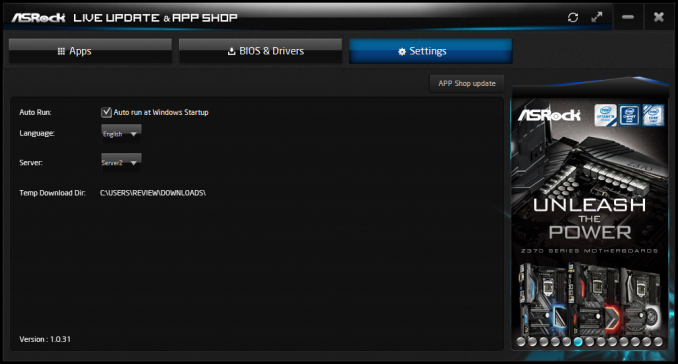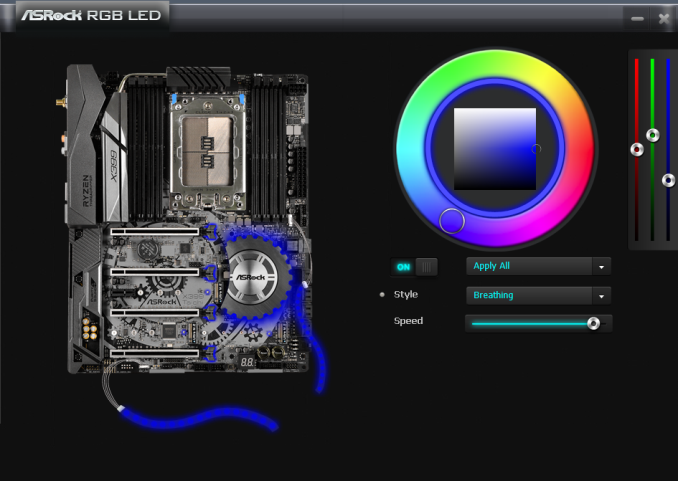The ASRock X399 Taichi Motherboard Review: Cost-Effective Threadripper
by E. Fylladitakis on October 26, 2018 8:00 AM EST- Posted in
- Motherboards
- AMD
- ASRock
- ThreadRipper
- X399
Software
The bundled DVD comes with a basic autorun software that includes a simple automated installer. It has five tabs, with the automated installer in the first tab. The automated installer will install all of the drivers and software for this motherboard's subsystems, plus Google’s Chrome Browser and Toolbar (even though the fifth tab is also dedicated to them).
The second tab, the "utilities" tab, includes the software that are not necessary for the proper operation of the motherboard, which are the ASRock RGB LED software and the simple "Restart to UEFI" utility. The "Restart to UEFI" is a mere shortcut that restarts the system and automatically enters the BIOS. Manuals and guides can be found under the Information tab and, finally, the company’s contact information is all that can be seen under the Contact tab.
ASRock's main software is the "Live Update & App Shop" utility, from which other secondary utilities can be installed and be kept up-to-date. The software also monitors the installed subsystem drivers and the BIOS version. By default, it will auto-start after the OS boots but this option can be manually disabled.
The ASRock RGB LED software is simple but very clean and easy to use. All of the options are gathered into a single page, where the user can simply choose a color and a visual effect and apply it to any of the motherboard's three LED zones. LED lighting can also be disabled from here. Unfortunately, there are no options to tie different lighting mode profiles to applications/games.
ASRock's A-tuning utility is a remade version of the F-stream utility that we find accompanying their more advanced motherboards. There is virtually no difference between the A-Tuning and the F-Stream utilities other than the theme. The A-tuning software still allows almost full control of the motherboard’s BIOS options via the OS. In its “OC Tweaker” tab we found most of the settings that are accessible via the BIOS screen, allowing for casual overclockers to experiment with minimal risk, as the settings reset when the system restarts. It is also handy for people who do not want a permanent overclock forced via the BIOS but prefer to boot with stock settings and force an overclock whenever they want or after the OS has booted. The A-Tuning software contains the "FAN-Tastic" utility as well, which allows for the graphical programming of fan cooling profiles.
























29 Comments
View All Comments
The_Assimilator - Friday, October 26, 2018 - link
Board Features/"In The Box" claims that you get Crossfire bridges with this board, but that's not reflected in the picture, plus bridgeless Crossfire has been a thing for years.Pretty luxurious of Asrock to include a 4-way SLI bridge, though... even if SLI is dead with RTX.
GreenReaper - Sunday, October 28, 2018 - link
I think the points just go through the board and the attachment plugs can go on either side, Maybe to store them in transit, or to discourage use of that slot because it gets disabled by the U.2 connector?Maryjohn0192 - Saturday, October 27, 2018 - link
good oneAntonErtl - Saturday, October 27, 2018 - link
I would have liked to see some information about ECC support. Does the board support it officially? Does the Linux kernel report that ECC is enabled if you supply ECC memory (and not if not)?kobblestown - Monday, October 29, 2018 - link
It does support ECC officially - that's what it says on the site and in the user manual. I have access to a TR machine with Asrock X399 Professional Gaming which is the same board as the Taichi but with a 10G Ethernet chip. The machine is equipped with 4x16GB ECC@2400MHz/s modules from Kingston. There are several BIOS options that seem related to ECC but there's no description of these options in the manual. Anyway, the kernel seems to be aware of the ECC. Here's a snippet from dmesg:EDAC amd64: Node 0: DRAM ECC enabled.
EDAC amd64: F17h detected (node 0).
EDAC MC: UMC0 chip selects:
EDAC amd64: MC: 0: 0MB 1: 0MB
EDAC amd64: MC: 2: 16383MB 3: 16383MB
EDAC amd64: MC: 4: 0MB 5: 0MB
EDAC amd64: MC: 6: 0MB 7: 0MB
EDAC MC: UMC1 chip selects:
EDAC amd64: MC: 0: 0MB 1: 0MB
EDAC amd64: MC: 2: 16383MB 3: 16383MB
EDAC amd64: MC: 4: 0MB 5: 0MB
EDAC amd64: MC: 6: 0MB 7: 0MB
EDAC amd64: using x8 syndromes.
EDAC amd64: MCT channel count: 2
EDAC MC0: Giving out device to module amd64_edac controller F17h: DEV 0000:00:18.3 (INTERRUPT)
EDAC amd64: Node 1: DRAM ECC enabled.
EDAC amd64: F17h detected (node 1).
EDAC MC: UMC0 chip selects:
EDAC amd64: MC: 0: 0MB 1: 0MB
EDAC amd64: MC: 2: 16383MB 3: 16383MB
EDAC amd64: MC: 4: 0MB 5: 0MB
EDAC amd64: MC: 6: 0MB 7: 0MB
EDAC MC: UMC1 chip selects:
EDAC amd64: MC: 0: 0MB 1: 0MB
EDAC amd64: MC: 2: 16383MB 3: 16383MB
EDAC amd64: MC: 4: 0MB 5: 0MB
EDAC amd64: MC: 6: 0MB 7: 0MB
EDAC amd64: using x8 syndromes.
EDAC amd64: MCT channel count: 2
EDAC MC1: Giving out device to module amd64_edac controller F17h: DEV 0000:00:19.3 (INTERRUPT)
EDAC PCI0: Giving out device to module amd64_edac controller EDAC PCI controller: DEV 0000:00:18.0 (POLLED)
AMD64 EDAC driver v3.5.0
CyrIng - Sunday, October 28, 2018 - link
What about Linux and FreeBSD?Can we have a review of Threadripper motherboards with some Kernel build benchmark for example?
kobblestown - Monday, October 29, 2018 - link
If you are interested in running Linux on TR you should check phoronix.com - they have benchmarks that are much more varied than what they do here.There is something else to note though - the experience has not been flawless for me. I snatched a 1920X at the time the 2990WX was announced a couple of months back for a great price that is no longer available and married it to an Asrock Fatal1ty X399 Professional Gaming with 4x8GB G.Skill 15-15-15-sth@3000MHz (not the machine from my post above). First of all, it takes ages to boot. That seem to be common for TR builds and is a bit annoying. But what annoys me the most is that the BIOS resets all settings every time you plug, unplug or change any PCIe/NVME device (not sure about the SATA since I rely on NVME entirely). The best approach is to save your settings (there are several save slots) and recall from there. Otherwise it's too much trouble because there are tons of options and most are not documented anywhere. I'm not even talking about overclocking - the machine is a beast even at stock freqs.
Also, you'd want to make sure that you run the latest BIOS/AGESA - for example the one the board came with did not allow for 3000MHz - only 2933 and 3066 (among others). The latest AGESA fixed this and my G.Skill which not validated for Ryzen works just fine. However, this latest version has some problem with the latest Linux kernels - for instance I couldn't run the Ubuntu 18.10 installer because of this kernel problem that can only be solved with custom compiled kernel (i.e. not with a boot option IIRC). OTOH, 18.04 runs just fine. I want to experiment with VGA passthrough and I have the hardware but haven't got the time yet. One thing to note is that all four network adapters (2x1G + 10G + WiFi) are in the same IOMMU group. It would have been nice to have the wired adapters in separate groups so I can assign them to different VMs but I think virtio-net will not break too much sweat on such a powerful machine.
CyrIng - Monday, October 29, 2018 - link
Thanks a lot for sharing this Linux experience.Phoenix is indeed a good Foss source but less hardware gifted as Anandtech.
As a System programmer, I would enjoy too see benchmarks dealing with Buildroot, FS squashing, cryptography support, big project compilation time and so on
Buying such hardware for a total of 1=3 $K claims à lot of details...
Regards
cyberguyz - Wednesday, October 31, 2018 - link
I have one of them. It works ok. Has problems running my GSkill TridentZ 3200 CL14 memory at XMP speeds without boosting memory voltage to 1.45v. Also it is a pain in the a$$ when it comes time to try out different settings since the only way to reset cmos is to open the system up and push a tiny little easy to miss button hear the onboard reset & power buttons. An external button like many of the competitors use would have been a real relief from that hassle.